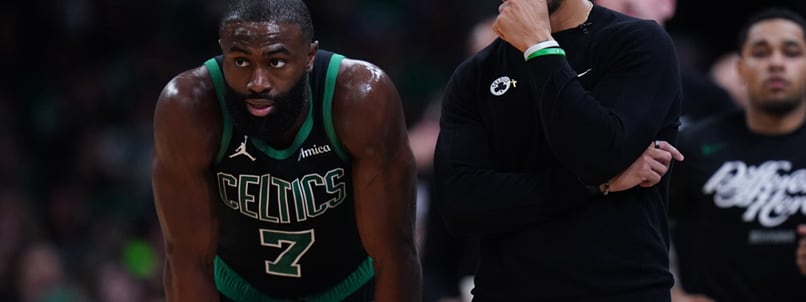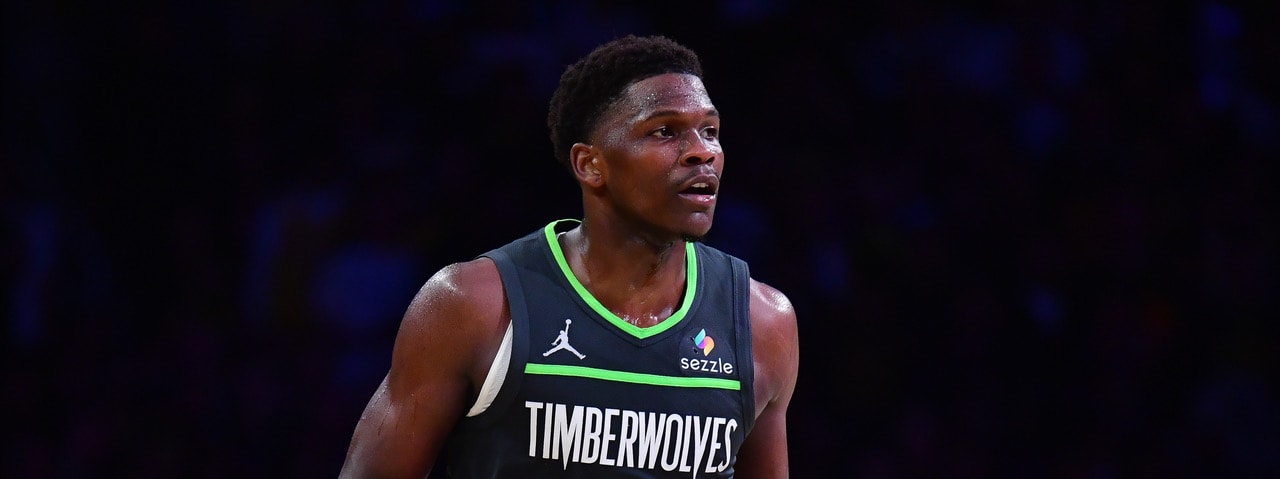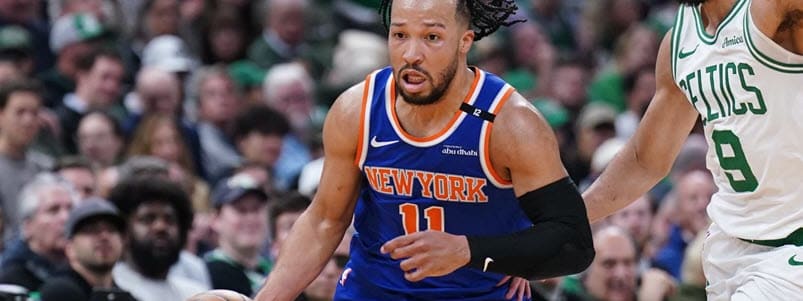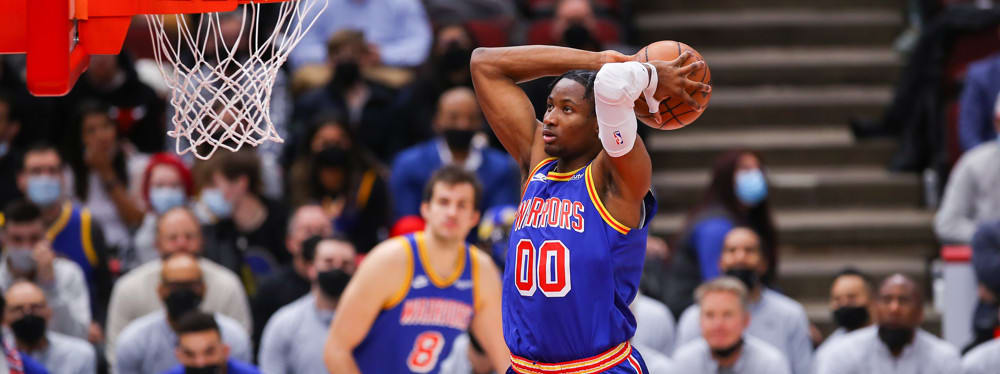Despite reaching his age 34 season, Curry's 2022-23 numbers remained MVP-caliber, and he made the All-NBA Second Team despite appearing in only 56 games -- missing time due to shoulder and knee injuries. Even with that being the case, Curry still ranked as the 13th-best fantasy asset in eight-cat roto leagues (total value). Putting aside his five-game 2019-20 campaign, Curry has never ranked lower than 10th in per-game value. His defense slipped some last season -- career-low 0.9 steals per game -- but his offense was nearly as potent as ever. The future Hall-of-Famer averaged 29.4 points on 49/43/92 shooting, 6.3 assists and 6.1 rebounds in 34.7 minutes. However, persistent injury issues are popping up. Since that five-game season, Curry has played 63, 54 and 56 games. Management's decision to trade Jordan Poole for Chris Paul throws a wrench into the equation as well, and an adjustment period may occur. Still, it seems unlikely Paul dominates the ball in a way that significantly detracts from Curry. The Warriors' star is still worthy of a first-round selection despite age, injury and a team shake-up.
Curry added to his already-Hall-of-Fame resume last season, claiming the 2022 Finals MVP award - his first. That said, Curry's regular season was a bit up and down. He still finished seventh in per-game fantasy production, but December and January were tough months for managers leaning on Curry. In those 27 games, he shot just 39.4 percent from the field. Curry made up for it with a scorching hot February and March (49.8 percent), but the full-season result was still just 43.7 percent shooting from the field - the lowest mark of his career and a significant drop-off from the 48.2 percent mark he hit in 2020-21. The veteran guard also took fewer shots, with Klay Thompson returning to the fold after two years on the sidelines. Decreased efficiency and volume led to Curry's points per game dropping from 32.0 to 25.5, which is what caused him to rank outside of the top five in per-game fantasy production for the first time since 2011-12. It's understandable if fantasy managers have concerns about Curry heading into his age-34 season, especially coming off his worst shooting year from the field and three. However, he demonstrated in the playoffs that he's still one of the league's best players. In the vast majority of fantasy drafts, he'll be selected in the top five, where he's finished most of his career.
After missing nearly all of 2019-20 due to a broken hand, Curry came back in massively impressive fashion last season. He ranked second in fantasy on a per-game basis -- the fourth time in his career he has ranked in the top 2. In 34.2 minutes per game, the future first-ballot Hall-of-Famer averaged a league-high 32.0 points, 5.8 assists, 5.5 rebounds and 1.2 steals. He also made a career-high 5.3 threes per game on 12.7 attempts (42.1 percent). The departure of Kevin Durant and absence of Klay Thompson (Achilles) forced Curry to take on a massive role for the Warriors, who just barely missed the playoffs as a result of failing to make it through the play-in games. As a testament to his superb season, Curry scored a career-high 62 points against the Trail Blazers in early January. With Thompson set to return during the upcoming season, Curry may not need to lead the league in scoring for the Warriors to make the playoffs, especially with the West less top-heavy due to the Clippers being down Kawhi Leonard and the Nuggets being down Jamal Murray to start the campaign. Still, Curry is an easy top-5 selection for fantasy managers in 2021-22. He's the fuel that ignites the Warriors' offense, and that will not change anytime soon.
The 2019-20 season was essentially lost for Curry, who played just five games due to a broken hand. He'll enter 2020-21 as a 32-year-old who hasn't crossed the 70-game threshold since 2016-17. Injury potential should be at the forefront of fantasy manager's minds before they draft Curry, but his upside is obvious. In 2018-19, he averaged 27.3 points, 5.3 rebounds, 5.2 assists, 5.1 threes and 1.3 steals per game, ranking as the fifth-best player in eight-category leagues on a per-game basis. With Kevin Durant out of the picture and Klay Thompson set to miss the season with a torn Achilles, it's possible Curry will take on more usage and handle the ball more than we've seen in recent years. For example, in the five games he played last season, he was on pace to average 8.5 assists per 36 minutes -- similar to his rate before Durant joined the Warriors. If Curry manages to stay healthy, he should provide early first-round fantasy value, and it seems likely he'll go top-5 in many drafts.
Curry is coming off of his sixth All-NBA selection, and he continues to assert himself as one of the best shooters of all time. Averaging 27.3 points in 2018-19, Curry drilled 5.1 threes per game at 43.7 percent, also making 47.2 percent of his field goals overall and converting 91.6 percent of his free throws. The sure-fire Hall-of-Famer also racked up 5.3 rebounds, 5.2 assists and 1.3 steals per contest. This season is especially interesting, as it's possible Curry will see his usage increase with the departure of Kevin Durant. The year prior to Durant's arrival (2015-16), Curry collected his second straight MVP award by averaging 30.1 points, 6.7 assists, 5.4 rebounds and 2.1 steals. But that's when Curry was 27 years old, and he'll now be 31. While he's had some injury concerns across the past two seasons, appearing in just 120 games, Curry remains among the elite fantasy assets when healthy and is worthy of a top-5 selection in almost all formats.
Nursing an ankle injury, Curry appeared in just 51 games last season -- his fewest since 2011-12. However, when he played, he was the most efficient player in league, leading all players in true shooting percentage (67.5). He achieved the feat through shooting 49.5 percent from the field, hitting 4.2 threes per tilt at 42.3 percent, and leading the NBA in free-throw percentage (92.1). That resulted in 26.4 points per game, plus averages of 6.1 assists, 5.1 rebounds and 1.6 steals. He also continued to be a big-game threat, as he posted 17 games with at least 30 points -- three of which were 40-point efforts. This year marks Curry’s age 30 seasons, but there are no signs of him slowing down, save for his ankle injury. However, prior to that, he had appeared in at least 78 games each season since 2012-13. Overall, even with the addition of DeMarcus Cousins, Curry’s usage and efficiency should remain high enough for him to be one of the best Fantasy players in the NBA.
Following back-to-back MVP campaigns in which he established new records for three-pointers in a single season, Curry was always going to be hard pressed to take his game to greater heights in 2016-17, especially after the Warriors added another former MVP to the roster in Kevin Durant. Indeed, Curry saw a nearly five-point drop in his scoring average and made one less three-pointer per game, but those that invested in the point guard on draft day may not have anticipated slight declines in just about every other category. Curry’s 46.7 percent mark from the field and career-worst 41.1 percent mark from 3-point range were somewhat disappointing given that the arrival of Durant was expected to open up more clean looks, though Curry still comfortably led the NBA with 324 three-pointers, and no other perimeter player could match his all-around efficiency. Perhaps owing to more comfort with playing alongside Durant, Curry seemed to hit his stride in postseason as the Warriors recaptured the title, averaging 28.1 points, 6.7 assists, 6.2 rebounds and 4.2 treys along the way. While Curry can no longer be considered the consensus top overall pick in most Fantasy settings, at 29 years old, he’s still firmly in the midst of his prime, which the Warriors surely recognized when they inked him to a record-breaking five-year, $201 million extension in the offseason. With that in mind, Curry still makes for a viable first-round selection in drafts, and the case could be made for him to be the top pick if a prospective owner believes he’ll be able to return to the peak levels of shooting efficiency he posted during his second MVP season. Since Curry has a full year of experience playing alongside Durant already under his belt, there should be less of an adjustment period between the two superstars to begin the upcoming season, seemingly making at least a minor improvement in Curry’s shooting percentages an inevitability.
Curry’s 2015-16 campaign will go down as one of the most transcendent individual seasons in NBA history. Coming off of his first championship, Curry soared past his 2014-15 MVP numbers, upping his scoring by nearly seven points per game to a league-leading 30.1, while adding 6.7 assists and 5.4 rebounds. Curry may not be more than an average defender in a real basketball sense, but he averaged an NBA-best 2.1 steals per game and led the league in total steals for the second straight season. On top of the counting stats, Curry remained the league’s best free-throw shooter (90.8%), converted 50.4 percent of his field goals, and shattered NBA records for single-season three-point attempts (886) and makes (402). The question now, of course, is how can Curry possibly follow up such a spectacular season? Unfortunately, for fantasy owners, the answer is a complicated one. After all, it’s not often the best regular season team in history replaces its weakest starter with one of the five best basketball players in the world, but that’s exactly what the Warriors did this summer. The addition of Kevin Durant undoubtedly makes Golden State a more dangerous team, but it threatens Curry’s reign as the NBA’s best fantasy player. Durant’s presence figures to bring an inherent decline to Curry’s usage rate and, in turn, his production -- just how much of a decline remains to be seen. Curry, in the midst of his prime, is still the NBA’s best outside shooter and the odds-on favorite to lead the league in three-pointers for a fifth straight season. His shooting percentages shouldn’t be in much jeopardy -- in fact, it’s reasonable to believe they could rise playing alongside Durant -- but a reduction in scoring appears all but inevitable. Curry’s rebounding numbers could also take a slight dip, though his assist production, which checked in below his career average last season, figures to, at worst, be sustainable.
Curry achieved the NBA's highest honor last season, earning the league's Most Valuable Player award while leading the Warriors to a 67-win season and the championship. In 80 games, he averaged a team-high 23.8 points to go along with 4.3 rebounds, 7.7 assists, and 2.0 steals in a career-low 33 minutes per game. Curry led the NBA in three-pointers made for a third straight season, knocking down 286 from beyond the arc, an all-time single-season NBA record. He also shot a league-best 91 percent from the free-throw line and topped the league in steals. Early on during his career, injuries were a concern but not so much any longer. He's missed just 10 games the last three seasons. Entering 2014-15, new head coach Steve Kerr announced his desire to limit Curry's exposure – playing him fewer minutes and having him play off the ball were a couple of ways to prevent injury and/or fatigue. The organization took steps to make life easier for Curry. They added a quality backup in Shawn Livingston, who along with Andre Iguodala, were capable enough ball handlers to take defensive pressure off Curry. As it turned out, the Warriors won so many games in blowout fashion, Kerr easily managed all of his starters' minutes. With Curry filling up so many fantasy categories, he's clearly become a top-five fantasy player.
Curry avoided significant injury for the second straight season in 2013-14, playing 78 games for the second consecutive season. Concerns about his wobbly ankles are slowly fading. He averaged a team-high 24.0 points on 47-percent shooting with 4.3 rebounds, 8.5 assists, 1.6 steals, and 0.2 blocks in 37 minutes per game. Curry also led the league in three-pointers made for a second straight season with 261. Not only is he one of the better field-goal shooters in the league, Curry is an excellent free-throw shooter. He made 89 percent of his freebies last season, and he's getting to the line more often, averaging a career-high 4.5 free-throw attempts per game. Curry can score from anywhere. Turnovers can be a problem, but he has improved his point-guard skills from when he first entered the league. Curry continues to hone his court vision, making those around him a little bit better. The 8.5 apg last year were good for sixth in the NBA. Heading into the new season, the Warriors added a competent backup point guard in Shaun Livingston, and we could see Curry playing a few minutes less per game at point guard, but he should continue to lead the Dubs in assists. A new head coach means some tweaks to the game plan, but Steve Kerr is a smart enough guy to leave Curry alone. Perhaps Kerr will give him some guidance in the finer points of point-guard play, but nothing needs to be done in terms of Curry's scoring or shot selection.
Fantasy players that gambled on Curry last season won big. There was plenty of doubt as to whether or not Curry would live up to his near-limitless promise coming off major ankle surgery, but the Warriors' floor general quieted the doubters by playing in 78 games – at a career-high 39 mpg average – scoring 22.9 points and dishing out 6.9 dimes per game (also career bests) and shooting a ridiculous 45.3 percent from long range while canning 272 threes on the season. Something of a statistical oddity – Curry actually shot better from three than he did overall (45.2 percent last season). For added value, he's one of the league's top free-throw shooters, converting 90 percent of his freebies last season. Of course, Curry will continue to be a gamble – ankle problems like his don't simply "go away" – he was slowed by another sprain during the Warriors' playoff loss to San Antonio - and every time he lands awkwardly, fantasy players will hold their collective breath until he starts running again. The departure of backup Jarret Jack is worrisome; his presence allowed Curry to play off the ball on occasion. Toney Douglas will take over the backup role this season, but he's not nearly as good a player.
This should be the year that Curry solidifies his place in the fantasy basketball top ten. He's that good. He has a three-point stroke like Ray Allen, converting at percentages you ordinarily see from seven-footers working in the low post. And with Monta Ellis out of the mix, he'll be the primary driving force for Golden State's offense this year. The one significant thing to worry about is that he's been a huge injury risk the last two seasons. Last season, he was limited to just 26 games (out of 66) in the lockout-shortened season. He had surgery in April to remove "loose bodies" from his ankle and has reportedly received a clean bill of health, but the time he missed over last season will almost certainly scare off a lot of potential fantasy owners. He’ll potentially be a buy-low candidate in the second, third, and fourth round of some drafts this season. Whether or not he’ll be worth the risk to draft him early will be based on the reports coming out of training camp. Make sure there are good indicators that he’s healthy before investing too heavily in him this season.
Just entering his third NBA season, Curry is already well-established as one of the league’s top backcourt scorers, combining the long-range shooting of a guard with percentages you might expect from a power forward (48.0% FG, 44.2% from three in 2010-11). But his team is in a state of flux; changes could be coming that will impact Curry’s production and overall fantasy value. First off, his first two seasons in the league were played under coaches Don Nelson and Nelson’s long-time assistant Keith Smart. The Warriors finished first and fifth in pace, respectively, in those years. New coach Mark Jackson may not have the team running quite as much. But Curry also shared a backcourt with Monta Ellis during those first two seasons, and if the trade rumors are to be believed, Ellis could be replaced by someone a little more defensive-minded (Philly’s Andre Iguodala, perhaps?). Both situations are worth watching closely when play resumes. Curry is recovering from May ankle surgery, but is expected to be at full strength for the start of the season.
In a draft class dominated by point guards, Curry emerged as top dog with his excellent court sense and that truly outstanding jump shot. He didn't come roaring out of the gate like Brandon Jennings; he got better as the season wore on, and in the month of April he averaged a staggering 26.4 points, 8.1 assists and 6.4 rebounds. And unlike many other guards, he's incredibly efficient – his shooting percentage from the field – 46.2 – looks like the number you'd get from a big man. He shot .437 from long range – seventh-best in the league – and made 166 threes on the year. And from the line he was close to perfect, with a free-throw percentage of .885. He could be even better this year, given the benefit of a year's experience in the league, the confidence that comes from a summer spent as one of the key players on Team USA, and a clear role as the Warriors' starting point guard from the outset of training camp.
Stephen Curry’s shot is NBA-quality. It remains to be seen if the rest of his game is at the same level. But Curry has a significant advantage over other elite NCAA scorers that haven’t achieved much of anything in the Association – I’m looking at you, J.J. Redick, and you, Adam Morrison. He’ll be playing for Don Nelson. Nellie can get away with playing two shoot-first pseudo-point guards – Curry and Monta Ellis – in the backcourt because he has Stephen Jackson to initiate the offense from the small forward position. That should give Curry the opportunity to do what he does best – shoot – without getting bogged down with the responsibility of running the offense.












